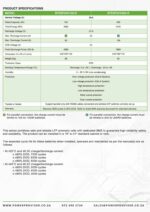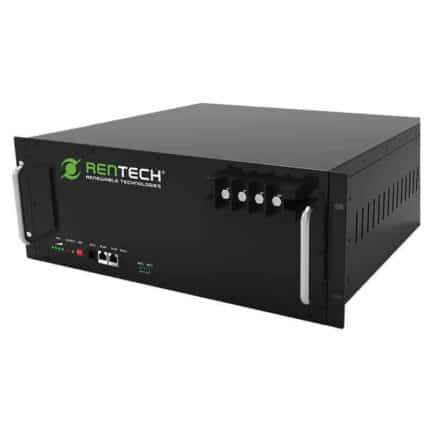
Singo 2000 Pro Portable UPS Power Station Special
R22,930.00 Original price was: R22,930.00.R12,995.00Current price is: R12,995.00. (incl. VAT)

Hubble X-101 Lithium Battery 5.5kWh 51V – Rack Mountable
R20,950.00 (incl. VAT)
Rentech 25.6V 200Ah Rack-Mounted Lithium-Ion Battery – (5.12kWh)
R24,095.00 (incl. VAT)
This Rack-Mounted Lithium-Ion Battery is designed for the solar and back-up power market. This series combines safe and reliable LFP prismatic cells with dedicated battery management systems (BMS) to guarantee high reliability, safety, and scalability.
The Rentech 25.6V 200Ah Rack-Mounted Lithium-Ion Battery – (5.12kWh) is designed for the solar / backup power market. This series combines safe and reliable LFP prismatic cells with dedicated BMS to guarantee high reliability, safety and scalability.
This product can be installed in a 19” or 21” standard cabinet or rack.
The expected cycle life for these batteries when installed, operated and maintained as per the manual are as follows:
- At 80% DoD, 6000 cycles
- At 90% DoD, 5000 cycles
It is very important to properly fully charge the battery after initial installation and leave it on charge without a load on for a couple of hours to ensure the BMS had a chance to balance the cells BEFORE you start using the battery.
It is also important to ensure that the battery is regularly fully charged and cells allowed to balance and not only operate it in partial state of charge mode for extended periods.
Out of stock
Do you need assistance selecting the right product? Contact us today.
Neil: +27 72 690 2734
Description
Rentech 25.6V Lithium-Ion Battery – 200Ah / 5.12kWh with Battery Management System has the following remarkable characteristics:
- Long lifespan of 6000 cycles at 80% DoD at 25’C.
- Excellent charge and discharge capacity.
- The Batteries can support up to 15 batteries in parallel for expansion.
- The Batteries are set to sleep mode (off) during transportation and storage to reduce loss of capacity.
- Also, disconnect active power from output terminals for enhanced safety.
- Lightweight and compact.
- Easy to install and maintain.
- Built-in Battery Management System (BMS).
- Rack installation design.
- Rentech 25.6V Lithium-Ion Battery – 200Ah / 5.12kWh is superior, empowering, and an excellent long-term investment.
- Environmentally friendly.
Rentech provides Lithium-ion batteries with proven Lithium Iron Phosphate (LifePO4) chemical composition.
This product has a 5-year warranty with a 10-year warranty option
Model: BTESF24V200-R
Voltage: 25.6V
Rated Capacity: 200Ah
Total Energy: 5.12 KWh
Recharge Voltage: 27.6V
Dimensions (mm): (d) 442 x (w) 430 (h) 175
Weight: 52,0kg
Cycle Life: >3500
- SAFETY
- Over voltage protections system
- Low voltage protection system
- High temperature protection
- Low temperature protection
- Short circuit protection
- Over current protection
BATTERY MANAGEMENT SYSTEM (BMS)
- Separate control and protection for the charge and discharge processes to maximize system availability
- Real-time detection of voltage, current, temperature and a variety of protection
- Support for parallel connection
CELL
- Lithium Iron Phosphate (LFP) prismatic cells with high safety and reliability
- Fully automated production following a mature and stable process, ensuring consistent charge / discharge performance and life span
- IEC62133, U and UN38.3 certifications
BENEFITS OF SOLAR BATTERIES
- Source of clean energy
- Reduced noise levels compared to generators
- Cost savings
- Uninterrupted electricity supply
CONSIDERATIONS WHEN CHOOSING SOLAR BATTERIES
Capacity and power ratings
- A battery’s capacity is the total amount of energy it can store, measured in kilowatt-hours (kWh). The power rating is the amount of electricity that a battery can deliver at one time, measured in kilowatts (kW). A battery with high capacity and low power rating will deliver a low amount of electricity for a long time. A battery with a low capacity and high-power rating can run an entire home or larger operation, but only for a few hours.
Depth of Discharge
- Most solar batteries need to retail some charge at all time due to their chemical composition and to prolong their lifespan. The DoD refers to the maximum of a battery’s capacity that should be used. For example, sealed lead-acid solar batteries are usually operated at £ 50% DOD to achieve a reasonable cycle life, while lithium-ion batteries can operate at 80% DOD, 8kWh from a 10kWh battery, and still provide 5 years or more cycle life.
Round-trip efficiency
- Round-trip efficiency represents the amount of energy that can be used as a percentage of the amount of energy required to fully charge a battery. For example, if a 5kWh capacity battery, which delivers 4 kWh electricity, would typically require 110% to 120% times the 4kWh to be fully recharged. The battery has 80% to 90% in round-trip efficiency. One should, however, remember that the battery is part of the total system, and the system also has inefficiencies and energy losses.
Battery life and warranty
A battery’s ability to hold a charge gradually decreases the more it is used. For example, a battery might be warrantied for 5000 cycles or 10 years at 70% of its original capacity. This means that at the end of the warranty, the battery will have lost no more than 30% of its original ability to store energy.
Solar batteries come with warranties that guarantee a certain number of cycles and/or years of useful life.
Additional information
| Weight | 52 kg |
|---|---|
| Dimensions | 44.2 × 43 × 17.5 cm |
Related products
Hubble AM-2 and Axpert Max-E 11kW Inverter Kit
In stock
















